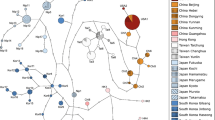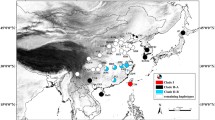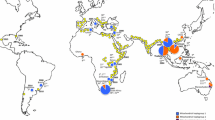Abstract
Elaborate and expensive endeavours are underway worldwide to understand and manage biological invasions. However, the success of such efforts can be jeopardised due to taxonomic uncertainty. We highlight how unresolved native range taxonomy can complicate inferences in invasion ecology using the invasive tree Acacia dealbata in South Africa as an example. Acacia dealbata is thought to comprise two subspecies based on morphological characteristics and environmental requirements within its native range in Australia: ssp. dealbata and spp. subalpina. Biological control is the most promising option for managing invasive A. dealbata populations in South Africa, but it remains unknown which genetic/taxonomic entities are present in the country. Resolving this question is crucial for selecting appropriate biological control agents and for identifying areas with the highest invasion risk. We used species distribution models (SDMs) and phylogeographic approaches to address this issue. The ability of subspecies-specific and overall species SDMs to predict occurrences in South Africa was also explored. Furthermore, as non-overlapping bioclimatic niches between the two taxonomic entities may translate into evolutionary distinctiveness, we also tested genetic distances between the entities using DNA sequencing data and network analysis. Both approaches were unable to differentiate the two putative subspecies of A. dealbata. However, the SDM approach revealed a potential niche shift in the non-native range, and DNA sequencing results suggested repeated introductions of different native provenances into South Africa. Our findings provide important information for ongoing biological control attempts and highlight the importance of resolving taxonomic uncertainties in invasion ecology.


Similar content being viewed by others
References
Allouche O, Tsoar A, Kadmon R (2006) Assessing the accuracy of species distribution models: prevalence, kappa and the true skill statistic (TSS). J Appl Ecol 43:1223–1232
Araújo MB, New M (2007) Ensemble forecasting of species distributions. Trends Ecol Evol 22:42–47
Castro-Díez P, Godoy O, Saldana A, Richardson DM (2011) Predicting invasiveness of Australian acacias on the basis of their native climatic affinities, life history traits and human use. Divers Distrib 17:934–945
Early R, Bradley BA, Dukes JS, Lawler JJ, Olden JD, Blumenthal DM, Gonzalez P, Grosholz ED, Ibañez I, Miller LP, Sorte CJB, Tatem AJ (2016) Global threats from invasive alien species in the twenty-first century and national response capacities. Nat Commun 7:12485
Ensing DJ, Moffat CE, Pither J (2013) Taxonomic identification errors generate misleading ecological niche model predictions of an invasive hawkweed. Botany 91:137–147
Gallien L, Thuiller W, Fort N, Boleda M, Alberto FJ, Rioux D, Lainé J, Savergne S (2016) Is there any evidence for rapid, genetically-based, climatic niche expansion in the invasive common ragweed? PLoS ONE 11:e0152867
Guisan A, Zimmermann NE (2000) Predictive habitat distribution models in ecology. Ecol Model 135:147–186
Henderson L (2007) Invasive, naturalized and casual alien plants in southern Africa: a summary based on the Southern African Plant Invaders Atlas (SAPIA). Bothalia 37:215–248
Hijmans RJ, Cameron SE, Parra JL, Jones PG, Jarvis A (2005) Very high resolution interpolated climate surface for global land areas. Int J Climatol 25:1965–1978
Holmes PM, Richardson DM, Esler KJ, Witkowski ETF, Fourie S (2005) A decision-making framework for restoring riparian zones degraded by invasive alien plants in South Africa. S Afr J Sci 101:553–564
Impson FAC, Kleinjan CA, Hoffmann JH, Post JM, Wood AR, Moran VC (2011) Biological control of Australian Acacia species and Paraserianthes lophantha (Willd.) Nielsen (Mimosaceae) in South Africa. Afr Entomol 19:186–207
Kodela PG, Tindale MD (2001) Acacia dealbata subsp. subalpina (Fabaceae: Mimosiodeae), a new species from south-eastern Australia. Telopea 9:319–322
Le Roux JJ, Brown GK, Byrne M, Ndlovu J, Richardson DM, Thompson GD, Wilson JRU (2011) Phylogeographic consequences of different introduction histories of invasive Australian Acacia species and Paraserianthes lophantha (Fabaceae) in South Africa. Divers Distrib 17:861–871
Marmion M, Parviainen M, Luoto M, Heikkinen RK, Thuiller W (2009) Evaluation of consensus methods in predictive species distribution modelling. Divers Distrib 15:59–69
Maslin BR, McDonald MW (2004) Acacia search. Evaluation of Acacia as a woody crop option for southern Australia. Rural Industries Research and Development Corporation, Canberra
Ndlovu J, Richardson DM, Wilson JRU, O’Leary M, Le Roux JJ (2013) Elucidating the native sources of an invasive tree species, Acacia pycnantha, reveals unexpected native range diversity and structure. Ann Bot 111:895–904
Paradis E (2010) pegas: an R package for population genetics with an integrated-modular approach. Bioinformatics 26:419–420
Paterson ID, Hoffmann JH, Klein H, Mathenge CW, Neser S, Zimmermann HG (2011) Biological control of Cactaceae in South Africa. Afr Entomol 19:230–246
Petit RJ, El Mousadik A, Pons O (1998) Identifying populations for conservation on the basis of genetic markers. Conserv Biol 12:844–855
Poynton RJ (2009) Tree planting in southern Africa. Other genera, vol 3. Department of Agriculture, Forestry and Fisheries, Pretoria, South Africa
Pyšek P, Hulme PE, Meyerson LA, Smith GF, Boatwright JS, Crouch NR, Figueiredo E, Foxcroft LC, Jarošik V, Richardson DM, Suda J, Wilson JRU (2013) Hitting the right target: taxonomic challenges for, and of, plant invasions. AoB PLANTS 5:plt042
R Core Team (2016) R: A language and environment for statistical computing. R Foundation for Statistical Computing, Vienna, Austria. https://www.R-project.org/
Rejmánek M, Richardson DM (2013) Trees and shrubs as invasive alien species—2013 update of the global database. Divers Distrib 19:1093–1094
Richardson DM, Kluge RL (2008) Seed banks of invasive Australian Acacia species in South Africa: role in invasiveness and options for management. Perspect Plant Ecol Syst 10:161–177
Robertson MP, Visser V, Hui C (2016) Biogeo: an R package for assessing and improving data quality of occurrence record datasets. Ecography 39:394–401
Saltonstall K (2002) Cryptic invasion by a non-native genotype of the common reed, Phragmites australis, into North America. Proc Natl Acad Sci USA 99:2445–2449
Swets KA (1988) Measuring the accuracy of diagnostic systems. Science 240:1285–1293
Thompson GD, Robertson MP, Webber BL, Richardson DM, Le Roux JJ, Wilson JRU (2011) Predicting the subspecific identity of invasive species using distribution models: Acacia saligna as an example. Divers Distrib 17:1001–1014
Thompson GD, Bellstedt DU, Richardson DM, Wilson JRU, Le Roux JJ (2015) A tree well travelled: global genetic structure of the invasive tree Acacia saligna. J Biogeogr 42:305–314
Thuiller W, Georges D, Engler R, Breiner F (2016) biomod2: Ensemble platform for species distribution modeling. R package version 3.3-7. https://CRAN.R-project.org/package=biomod2
Van Wilgen BW, Dyer C, Hoffmann JH, Ivey P, Le Maitre DC, Richardson DM, Rouget M, Wannenburgh A, Wilson JRU (2011) National-scale strategic approaches for managing introduced plants: insights from Australian acacias in South Africa. Divers Distrib 17:1060–1075
Wardill TJ, Graham GC, Zalucki M, Palmer WA, Playford J, Scott KD (2005) The importance of species identity in the biocontrol process: identifying the subspecies of Acacia nilotica (Leguminosae: Mimosoideae) by genetic distance and the implications for biological control. J Biogeogr 32:2145–2159
Acknowledgements
Funding was provided by the DST-NRF Centre of Excellence for Invasion Biology and the Working for Water Programme through their collaborative research project on “Integrated Management of invasive alien species in South Africa” and a Subcommittee B grant from Stellenbosch University (to JLR), and the Drakenstein Trust. Additional financial support was provided by the DST-NRF Centre of Excellence for Invasion Biology, Stellenbosch University, and the National Research Foundation of South Africa (Grant Nos. 85417 to DMR). We thank C. Gairifo, J. Ndlovu, and J.R.U. Wilson for collecting and/or providing samples analyzed in this study, and H. Kaplan for supplying occurrence records listed in the Southern African Plant Invaders Atlas. We are grateful to M.J. Koordom and P.H. Du Preez for assistance in the laboratory. We also thank the two anonymous referees whose suggestions helped to clarify and improve this manuscript significantly.
Author information
Authors and Affiliations
Corresponding author
Electronic supplementary material
Below is the link to the electronic supplementary material.
Rights and permissions
About this article
Cite this article
Hirsch, H., Gallien, L., Impson, F.A.C. et al. Unresolved native range taxonomy complicates inferences in invasion ecology: Acacia dealbata Link as an example. Biol Invasions 19, 1715–1722 (2017). https://doi.org/10.1007/s10530-017-1381-9
Received:
Accepted:
Published:
Issue Date:
DOI: https://doi.org/10.1007/s10530-017-1381-9




